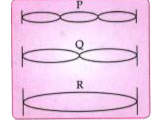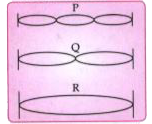Amplitude of vibration is A=F0p−q+r . Resonance will occur when
p=0,q=r
p=q=r
p=−r,q=0
Both (1) & (3)
The correct Answer is:4
To determine when resonance occurs in the given equation for amplitude A=F0p−q+r, we need to analyze the conditions under which the amplitude becomes maximum, or theoretically infinite.
1. Understanding Resonance: Resonance occurs when the amplitude of the oscillation reaches its maximum value. Mathematically, this can be expressed as Amax=∞.
2. Setting Up the Equation: From the given equation, we have:
A=F0p−q+r
For resonance (maximum amplitude), we set:
F0p−q+r=∞
3. Analyzing the Condition: The above equation implies that the denominator must approach zero:
p−q+r=0
4. Rearranging the Equation: We can rearrange the equation to find the condition for resonance:
p+r=q
5. Testing Options: We will now test the provided options to see which satisfy the condition p−q+r=0.
- Option 1: p=0,q=r
0−q+q=0(Valid)
- Option 2: p=q=r
p−p+p=p(Not valid, as it does not equal 0)
- Option 3: p=−r,q=0
−r−0+r=0(Valid)
- Option 4: Both options 1 and 3 are correct.
6. Conclusion: Therefore, resonance will occur under the conditions specified in options 1 and 3.
Final Answer:
Resonance will occur when p−q+r=0. The valid options are 1 and 3.
---
A=F0p−q+r
For resonance (maximum amplitude), we set:
F0p−q+r=∞
p−q+r=0
p+r=q
0−q+q=0(Valid)
- Option 2: p=q=r
p−p+p=p(Not valid, as it does not equal 0)
- Option 3: p=−r,q=0
−r−0+r=0(Valid)
Resonance will occur when p−q+r=0. The valid options are 1 and 3.
Topper's Solved these Questions
- OSCILLATIONSBook:AAKASH INSTITUTE ENGLISHChapter:OSCILLATIONSExercise:ASSIGNMENT (SECTION-B )
Explore 25 Videos
- OSCILLATIONSBook:AAKASH INSTITUTE ENGLISHChapter:OSCILLATIONSExercise:ASSIGNMENT ( SECTION-C )
Explore 11 Videos
- OSCILLATIONSBook:AAKASH INSTITUTE ENGLISHChapter:OSCILLATIONSExercise:Try Yourself
Explore 86 Videos
- NUCLEIBook:AAKASH INSTITUTE ENGLISHChapter:NUCLEIExercise:ASSIGNMENT (SECTION-D)
Explore 10 Videos
- PHYSICAL WORLDBook:AAKASH INSTITUTE ENGLISHChapter:PHYSICAL WORLDExercise:ASSIGNMENT (Section-B)
Explore 4 Videos
Similar Questions
The amplitude of a particle under forced vibration is given as A=10x2−5x+6. Resonance will takes place at x equal to
View SolutionAssertion : Resonance is special case of force vibration in which the nature frequency of vebration of the body is the same as the impressed frequency of external periodic force and the amplitude of force vibration is maximum
Reason: The amplitude of forced vibrations of a bodyincrease with an increase in the frequency of the externally impressed perioic force
View Solution
Knowledge Check
In case of a forced vibration, the resonance wave becomes very sharp when the
Arestroring force is smallBdamping force is smallCquality factor is smallDapplied periodic force is small.
In case of a forced vibration the resonance wave becomes very sharp when the
View SolutionThe diagram below shows three different modes of vibration P, Q and R of the same string of a given length.

What is the ratio of the wavelength of vibrations P and R?
View SolutionThe adjacent diagram shows three different modes of vibrations P, Q and R of the same string.

State the ratio of wavelengths of P and R.
View SolutionThe diagram below shows three different modes of vibration P, Q and R of the same string of a given length.

Which vibration will produce a louder sound and why?
View SolutionThe adjacent diagram shows three different modes of vibrations P, Q and R of the same string.

Which vibration will produce a louder sound and why?
View SolutionAssertion (A): Equation (x−p)(x−q)−r=0 where p,q,rεRand0<p<q<r has roots in (p,q), Reason(R): A polynomial equation f(x)=0 has odd number of roots between aandb(a<b)iff(a)andf(b) have opposite signs
View Solution(a) If r2=pq, show that p:q is the duplicate ratio of (p+r) : (q+r).
(b) If (p−x):(q−x) be the duplicate ratio of p:q then show that : 1p+1q=1r.
View Solution